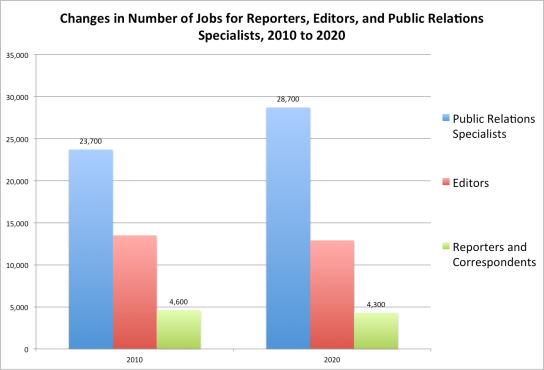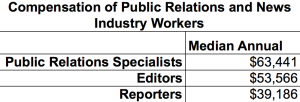Public Relations Specialists Outnumber Reporters 5 to 1

Source: California Employment Development Department data, http://www.labormarketinfo.edd.ca.gov/LMID/Projections_of_Employment_by_Industry_and_Occupation.html
California’s Bay Area is a sprawling megalopolis of more than 7.5 million people. Its overlapping complex of local governments and public authorities collect and spend tens of billions of dollars yearly. Many of the state’s top offices, courts, and regulatory agencies are located here. They decide on important stuff like energy policy and consumer law. And the Bay Area is host to hundreds of major corporations, including the fourth largest bank in the U.S., most of the largest Internet and biotechnology companies, and the ninth largest oil company in the world.
What happens in the Bay Area, be it technological advances in computing and medicine, or new laws governing property rights and taxation, influences the direction of not only other states east of us, but in fact the entire world. This place is a global epicenter of change.
That means that California’s Bay Area is a political battleground of the highest stakes, and the conflicts here will reverberate around the planet. Labor vs. capital. Immigration. Corporations and the environment. Racial and gender inequalities. Taxes and the social safety net. Policing and surveillance. Public education and its privatization.
A lot happens here, and it’s important that the Bay Area’s centers of power be investigated and held accountable.
But this just isn’t happening. Unfortunately there’s too few actual journalists in the Bay Area these days to keep track of all the changes, and peel back the layers of government and corporate activity. Sure, everyday there’s a flood of new information on the Internet, and even in print, about the latest government scandal, the big money trying to buy a vote or shape a policy, about the wrongdoing of companies, or disturbing environmental crises that are intensifying around us. Stepping back, however, and taking in the whole offering of journalism written here in the Bay Area, about what’s going on in this place, one can’t help but be disappointed. Contemporary journalism about this place is disjoint, and missing a lot. In particular there’s an absence of deeper investigative work examining changes in the economy, and the new inequalities that are being concretized.
Why is this?
Part of the answer is that journalism as an independent profession continues to be hollowed out. Of course the newspapers and magazines of the pre-Internet age were deeply flawed, and the media has never been an oppositional institution. But in prior eras there was a press corps, and for all their flaws and biases the reporters and editors were many in number, enough so that more than a few muckrakers could find institutional bases from which to do work that requires deep digging, perseverance, and a living wage. Plenty of people could make careers by telling stories about abuses of power by wealthy capitalist interests, or the malfeasance of politicians and bureaucrats. Not anymore.
And it’s getting worse. Over the next six years the number of reporters and editors employed in California will continue to drop. There’s already only about 4,600 reporters in California. Many of them work for trade publications, or they write about art, film, music, food. Those are worthy and interesting subjects, but without politics a newspaper becomes Sunset Magazine. Without political content a media outlet is entertainment. It no longer serves a public purpose. Who knows what the actual number is of reporters who are trying to investigate and write about society and politics with a critical eye to power? It’s probably a fraction of 4,600.

Working in the public relations industry is much more lucrative than being a reporter or editor. Source: California Employment Development Department.
What’s really disturbing is that the overall number of people employed in the media industry in California is growing, but these jobs are focused on producing entertainment and advertisements. But worst of all is where all the former journalists are heading: the public relations industry. Again, there’s only about 4,600 actual reporters in California, and the number focused on politics is much smaller, but the state’s public relations industry has over 23,000 jobs. These are full time jobs crafting stories that valorize powerful interests. These are jobs at the big banks, the big oil companies, and inside the halls of government. These are jobs with the boutique PR firms of the Bay Area that are hired at exorbitant rates by companies and governments to handle crises, or to produce slick PR campaigns. These are jobs producing phoney news web sites that tow the line of corporate giants. What does it say about our society that for every reporter there are five or more PR specialists out there putting their spin on information?
According to the state’s Economic Development Department, between 2010 and 2020 the public relations industry in California will add 5,000 more “specialist” jobs. That’s 5,000 more full time spinners managing the flow and content of information about governments and corporations. That’s 5,000 additional PR jobs, more jobs added in the PR industry than there are total reporter jobs existing. Meanwhile the number of jobs for reporters, for those who are trying to eke out a somewhat independent role digging up information and telling stories about power and politics, are projected to continue slowly declining.

Pingback: Chart of the day: Blood on the newsroom floor | eats shoots 'n leaves